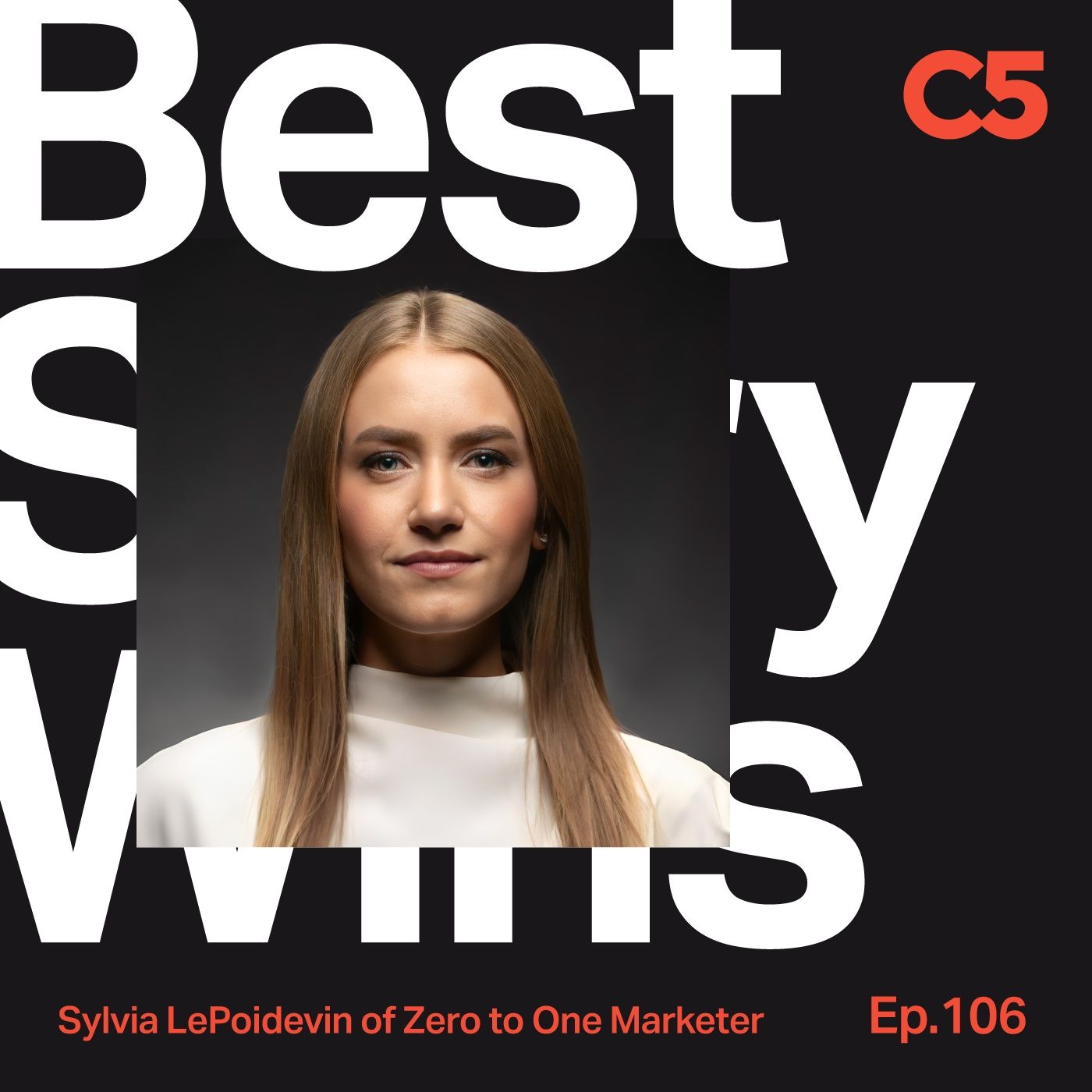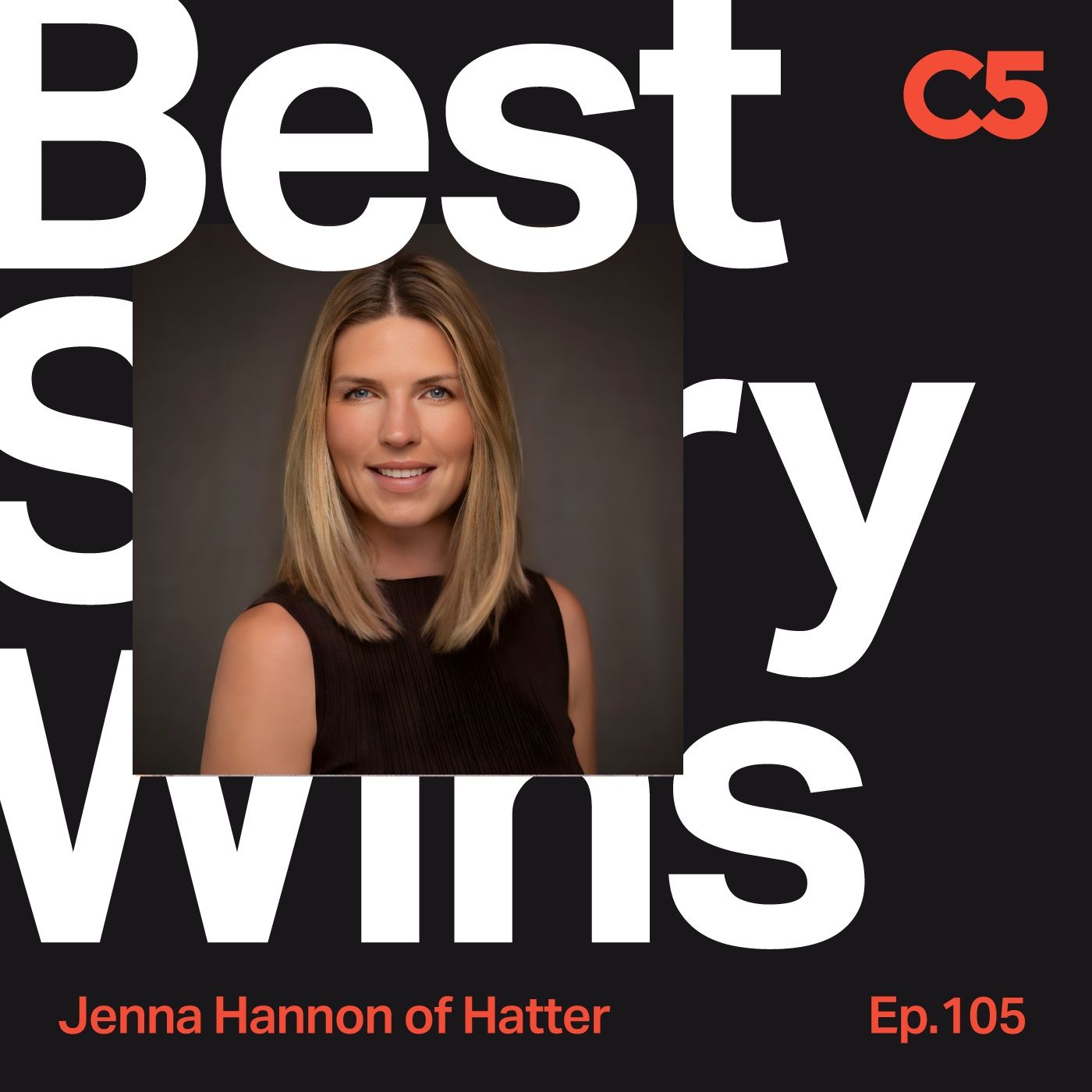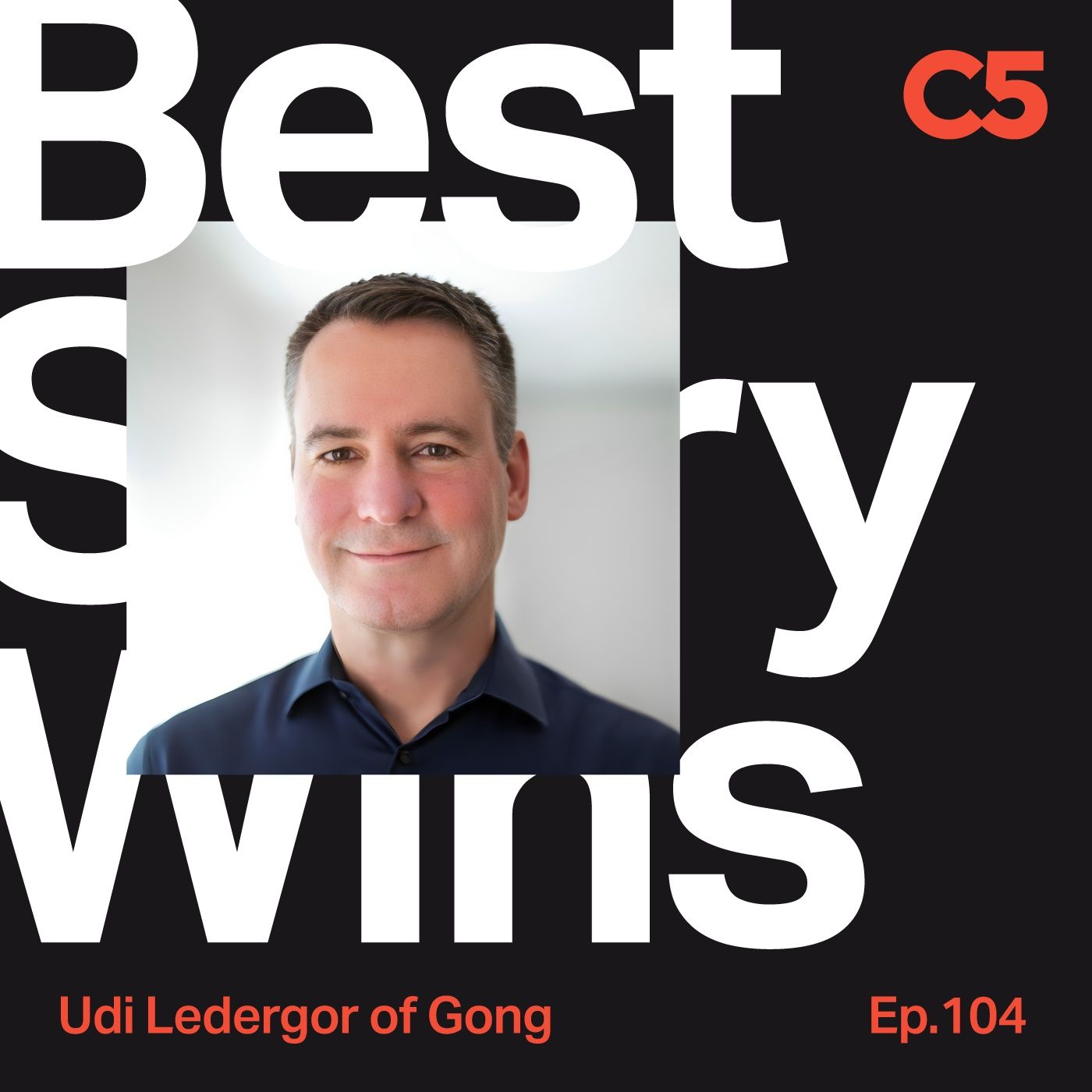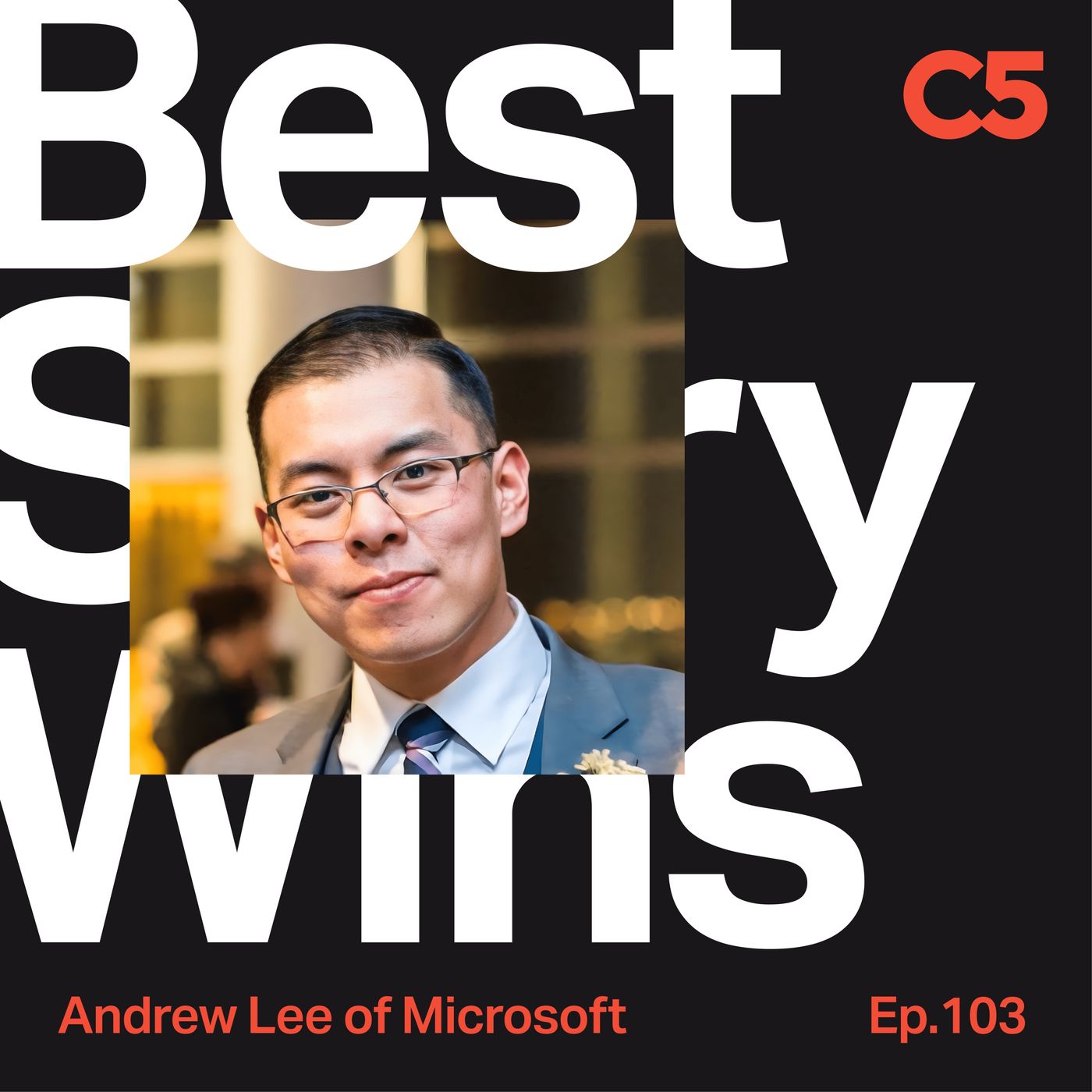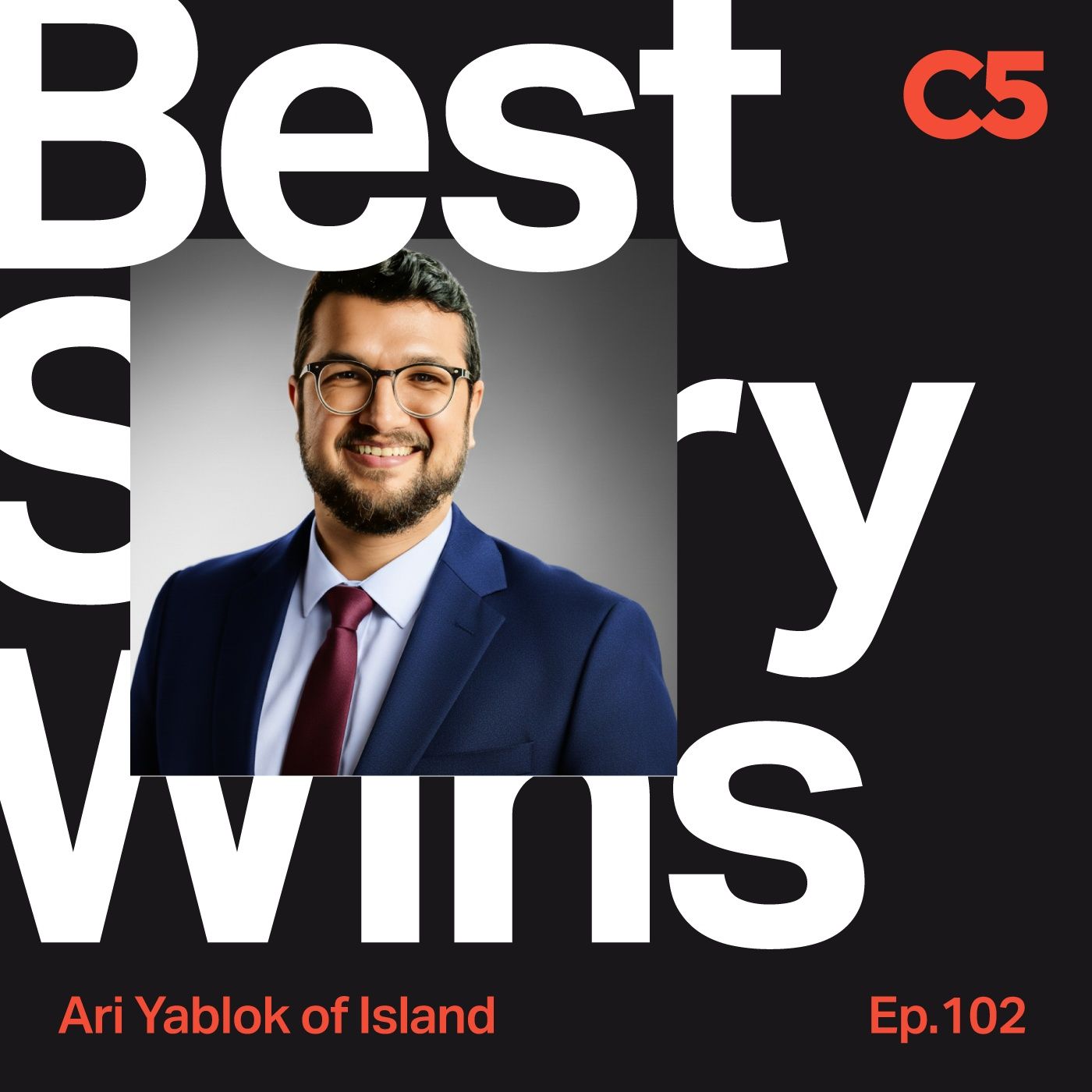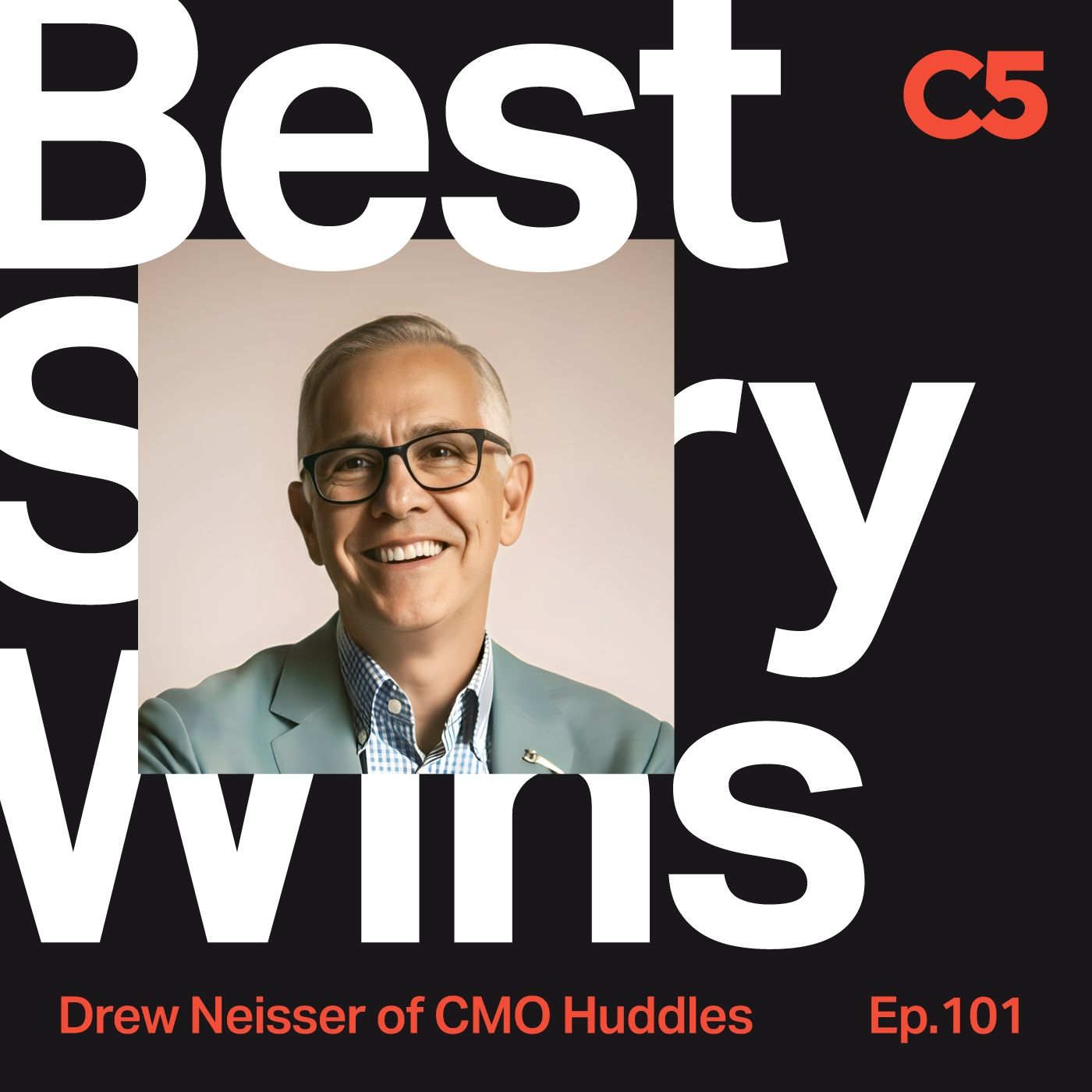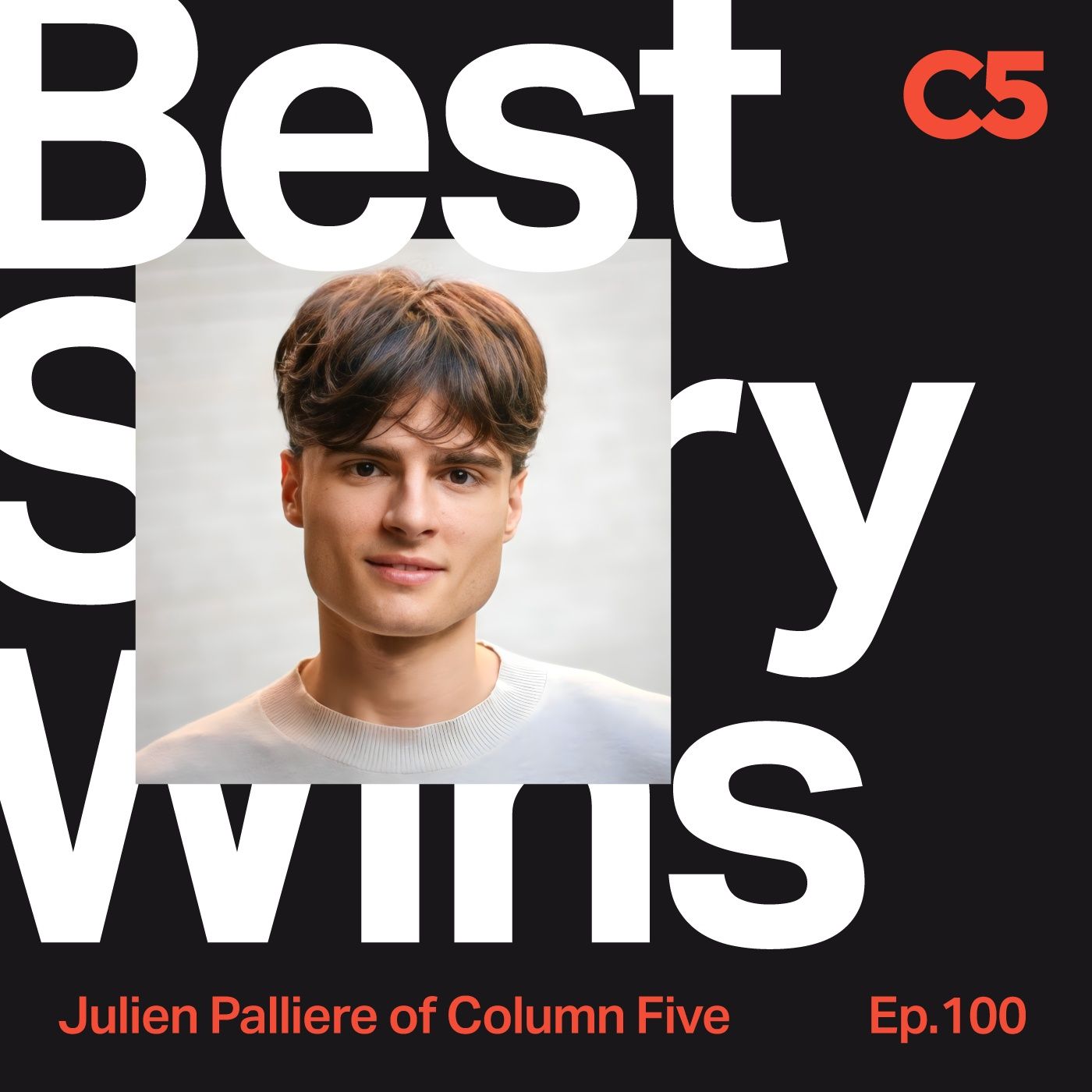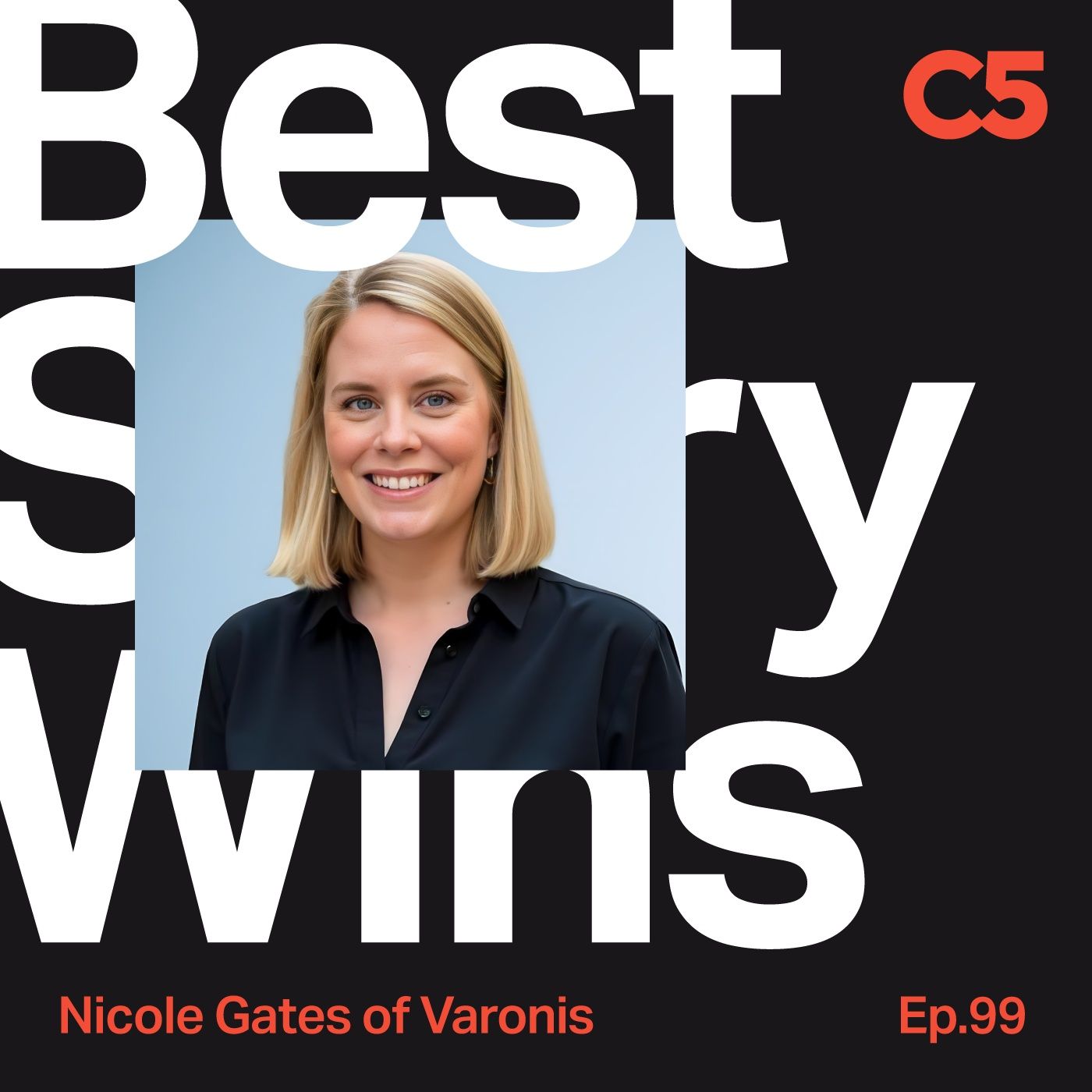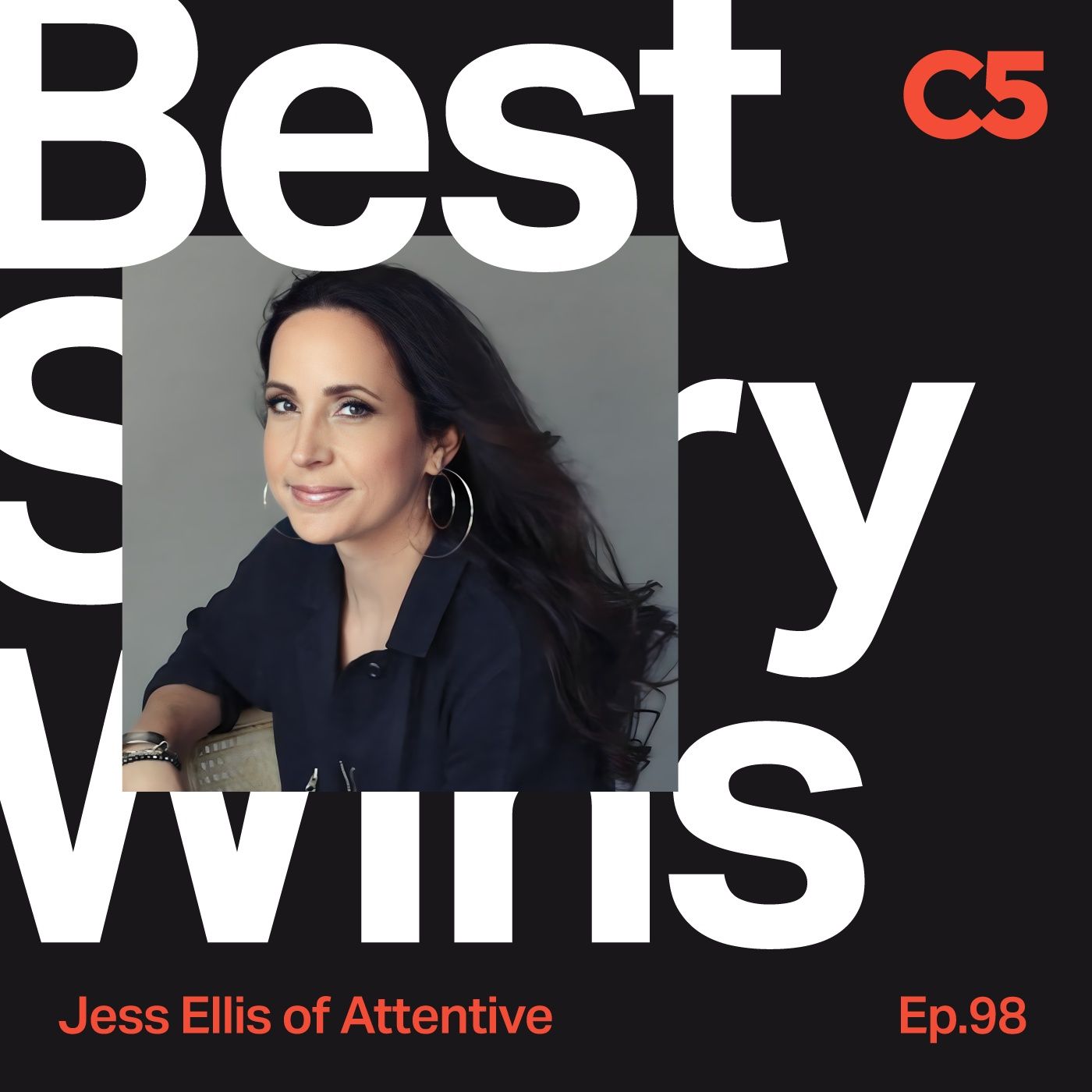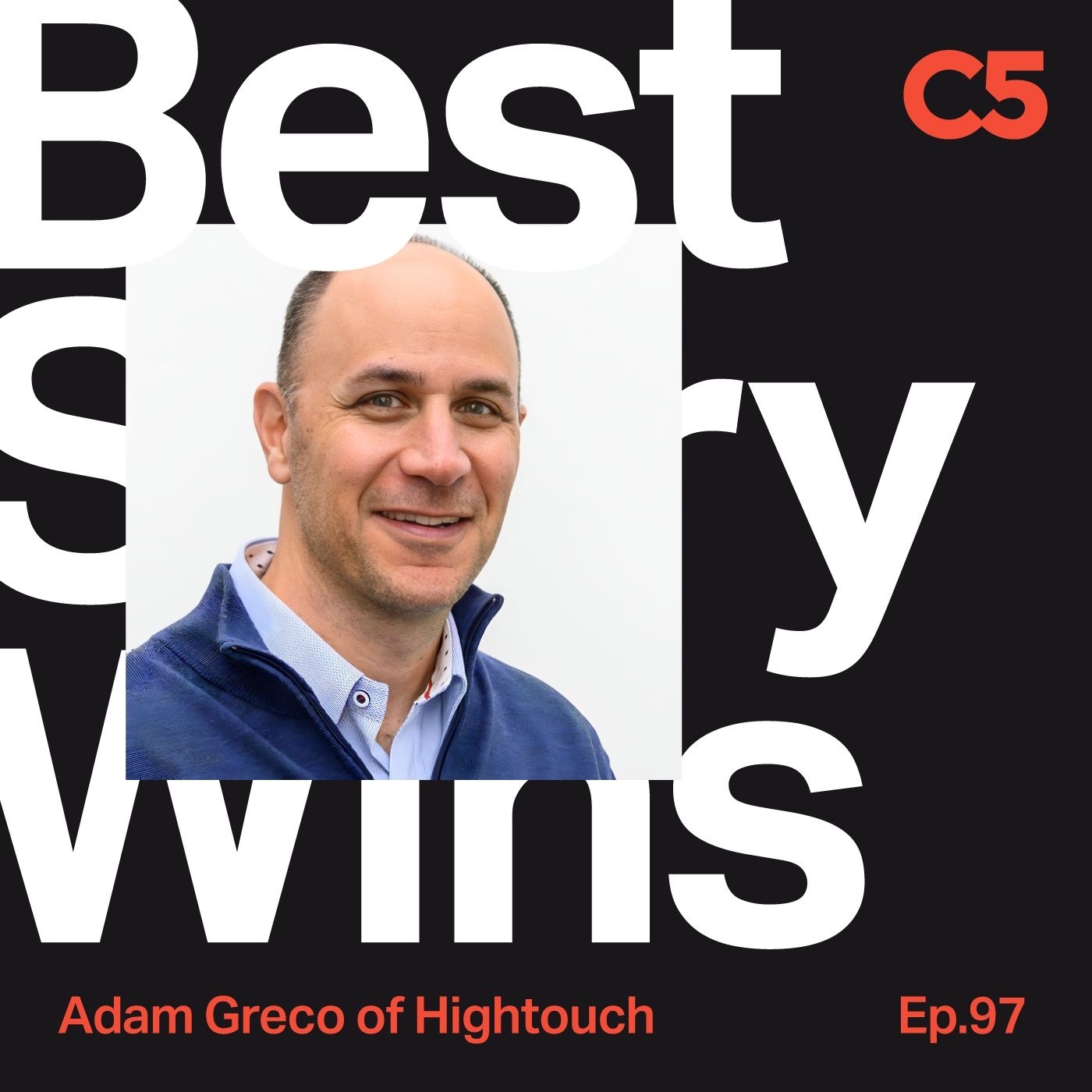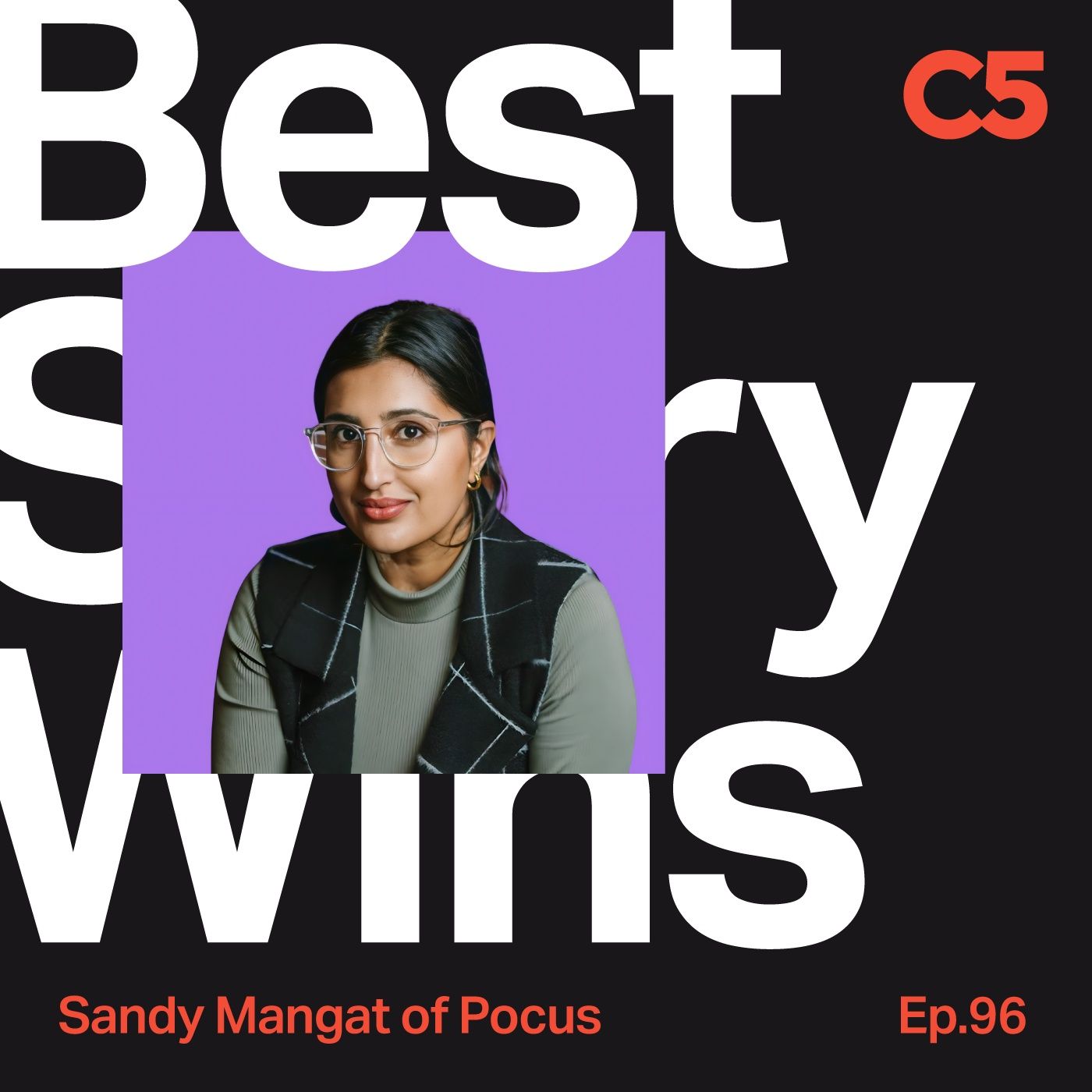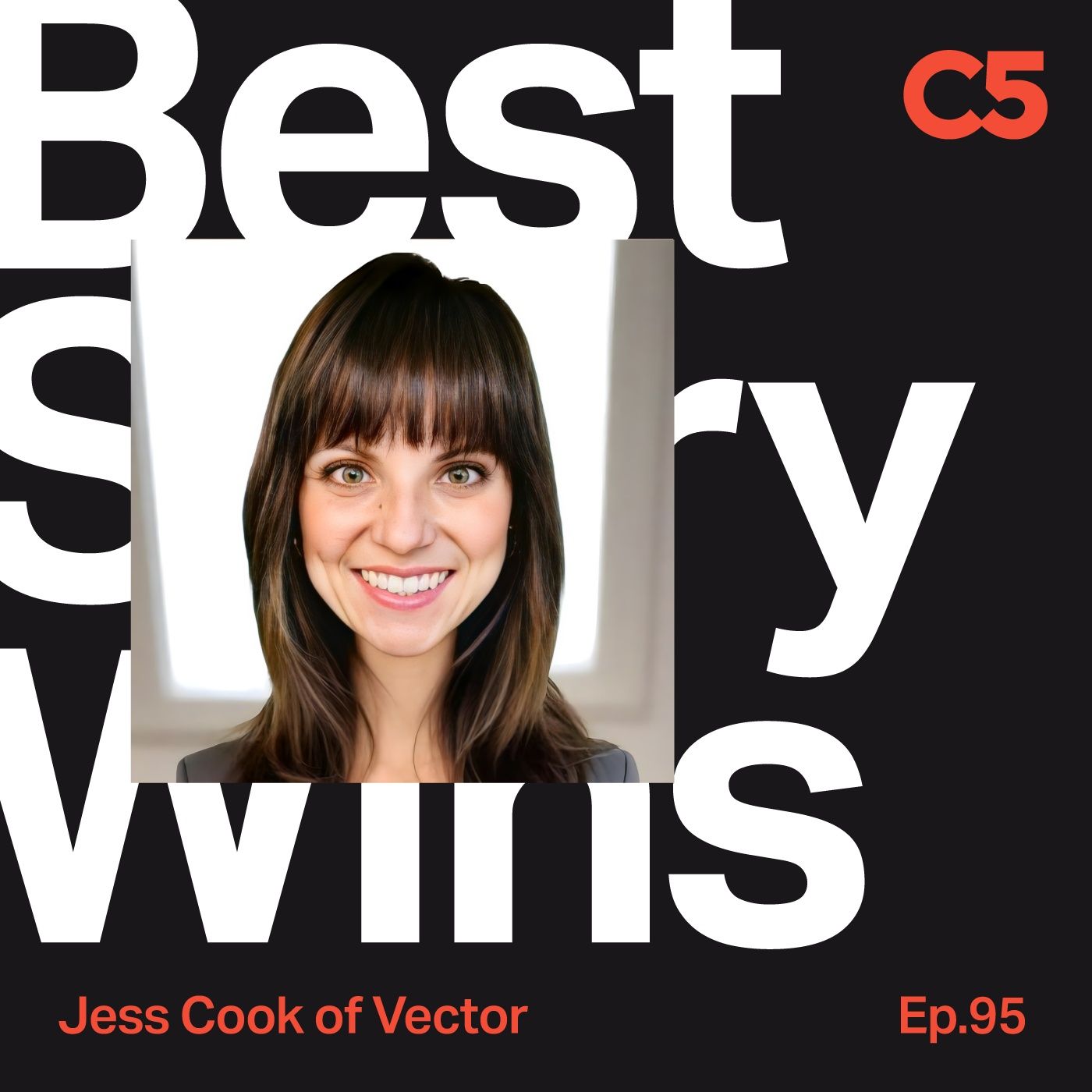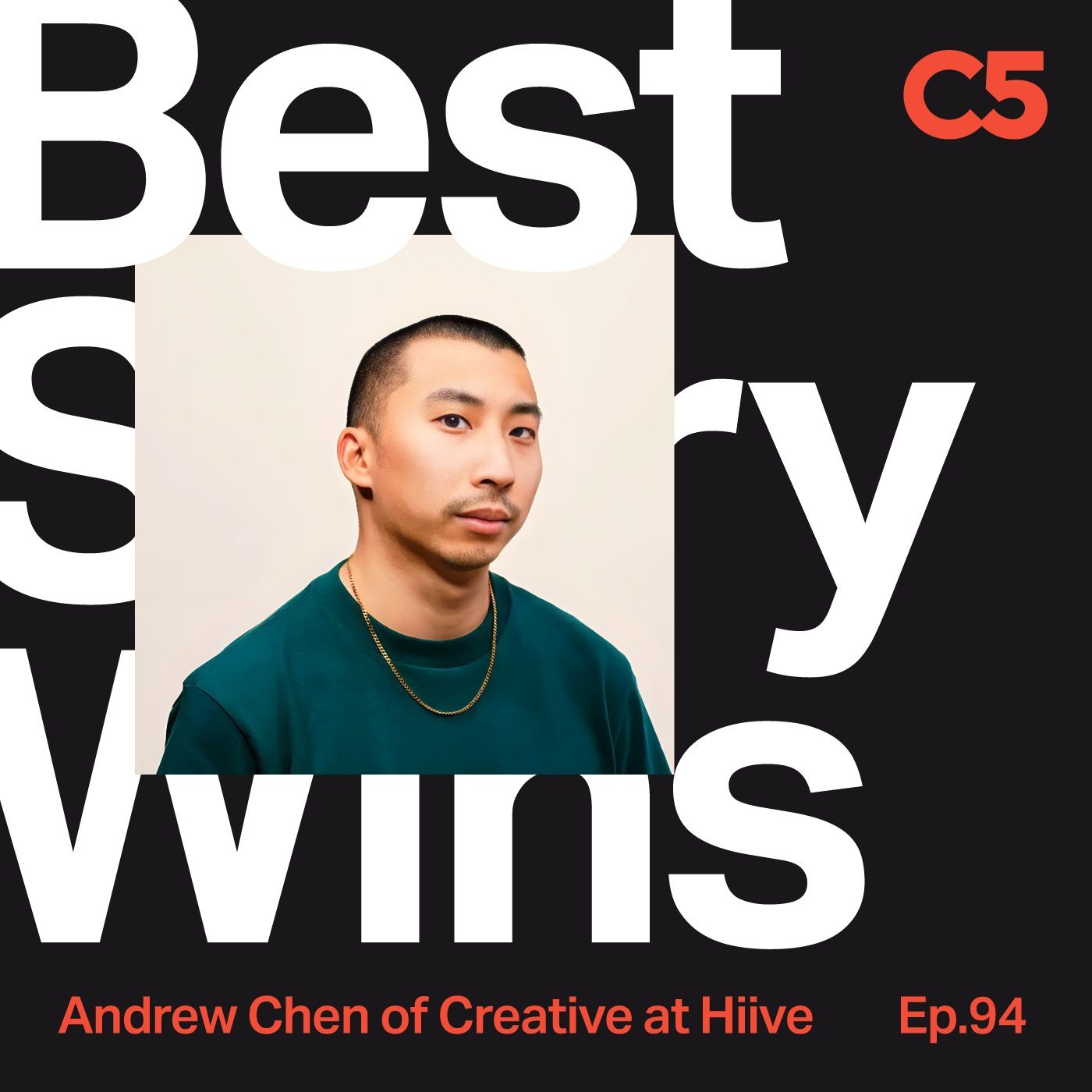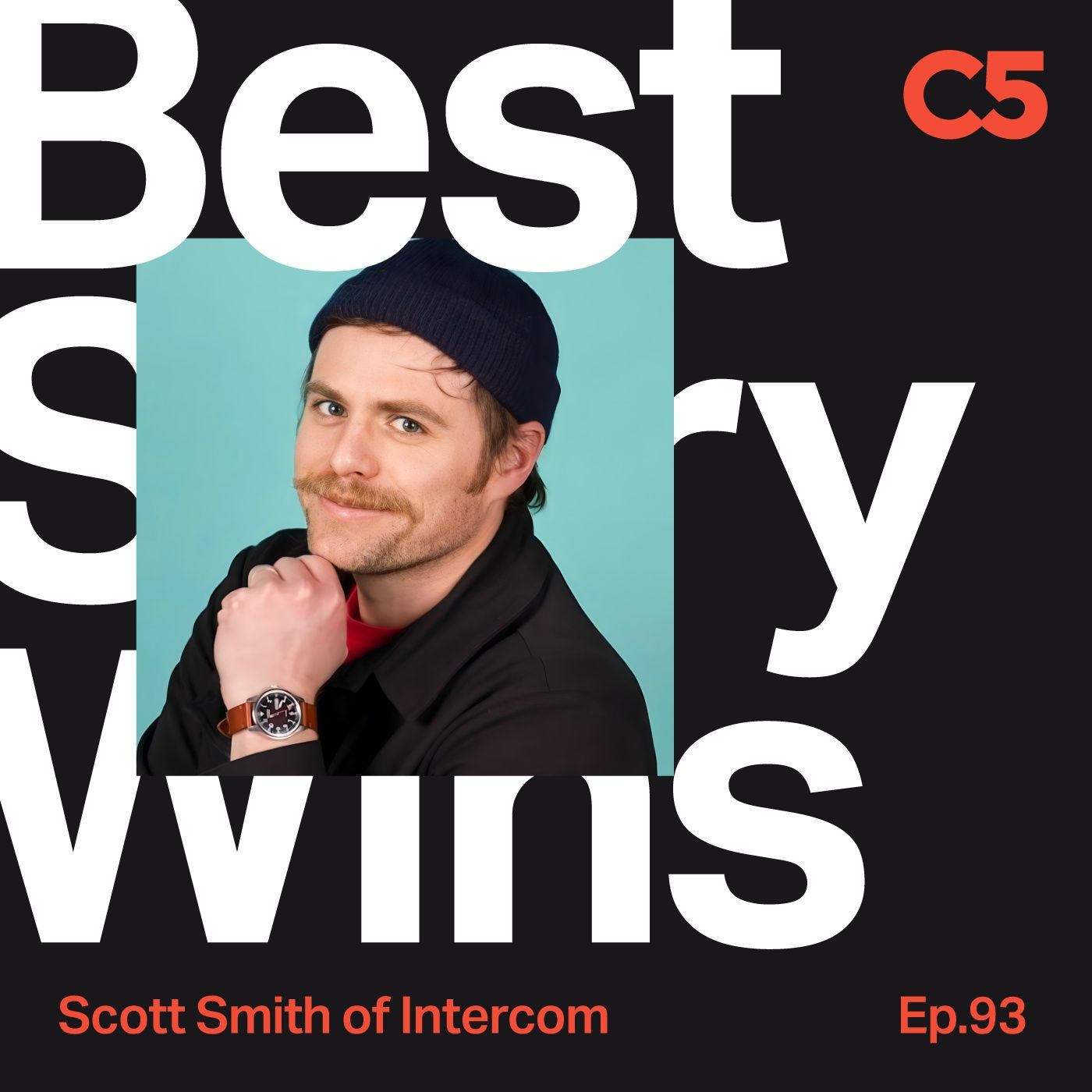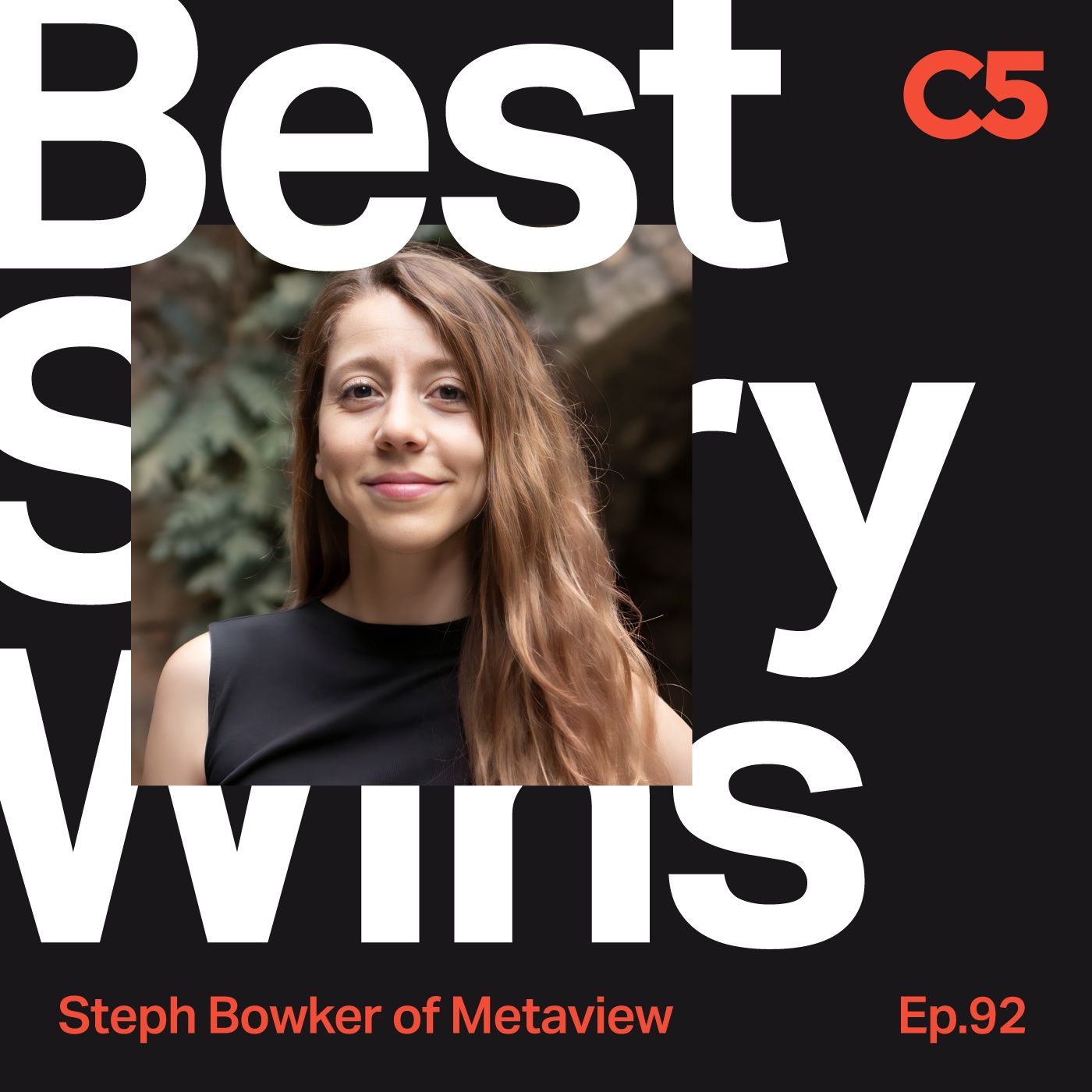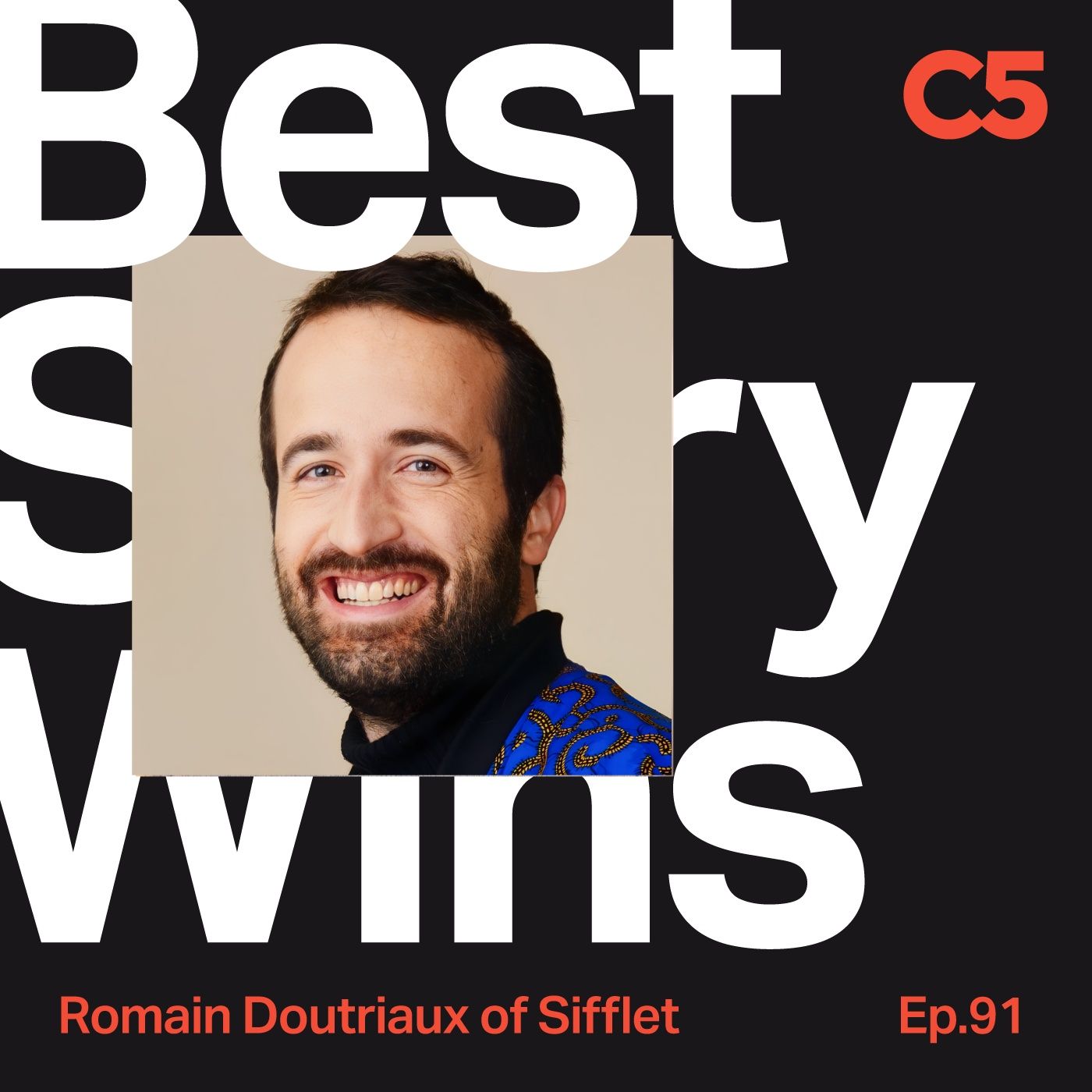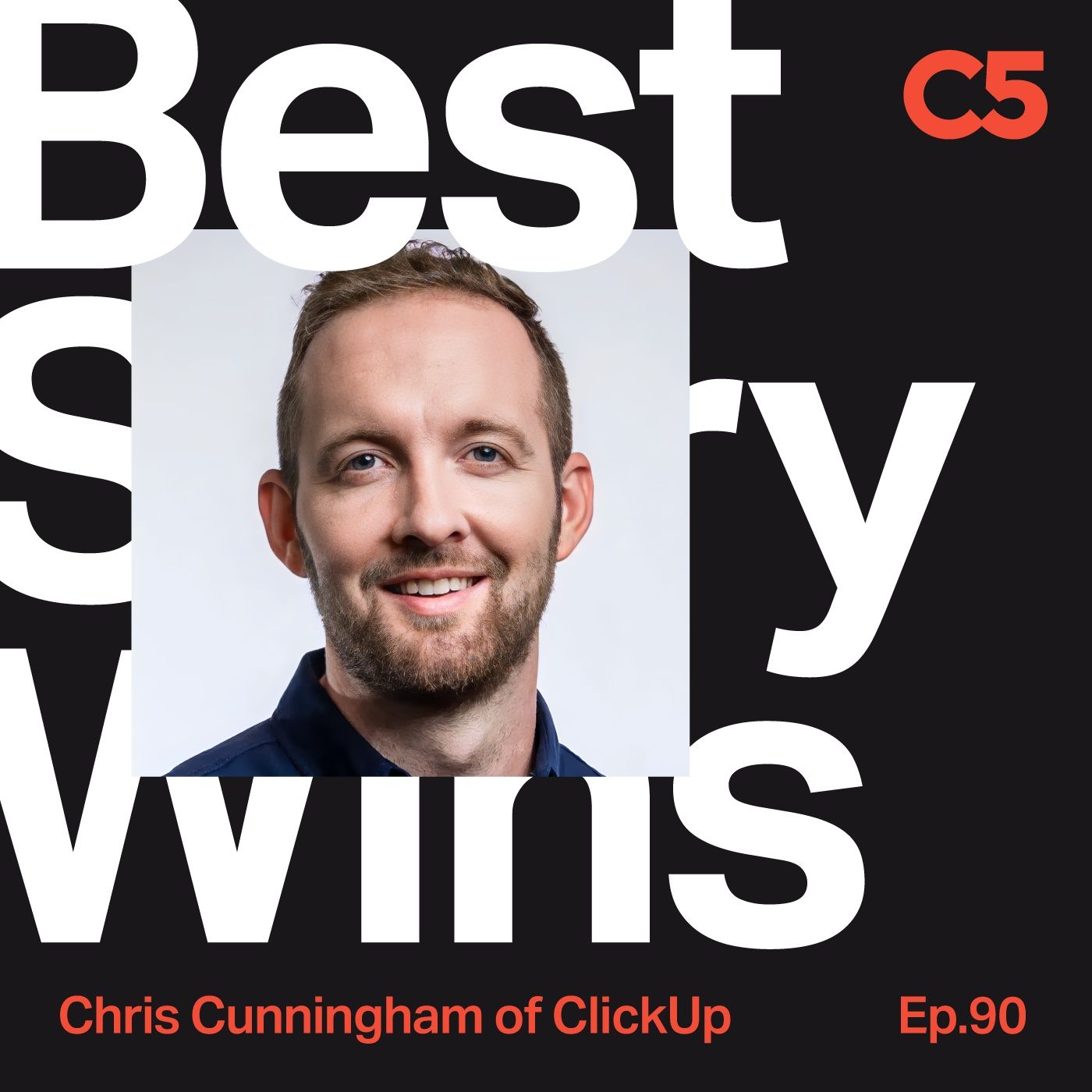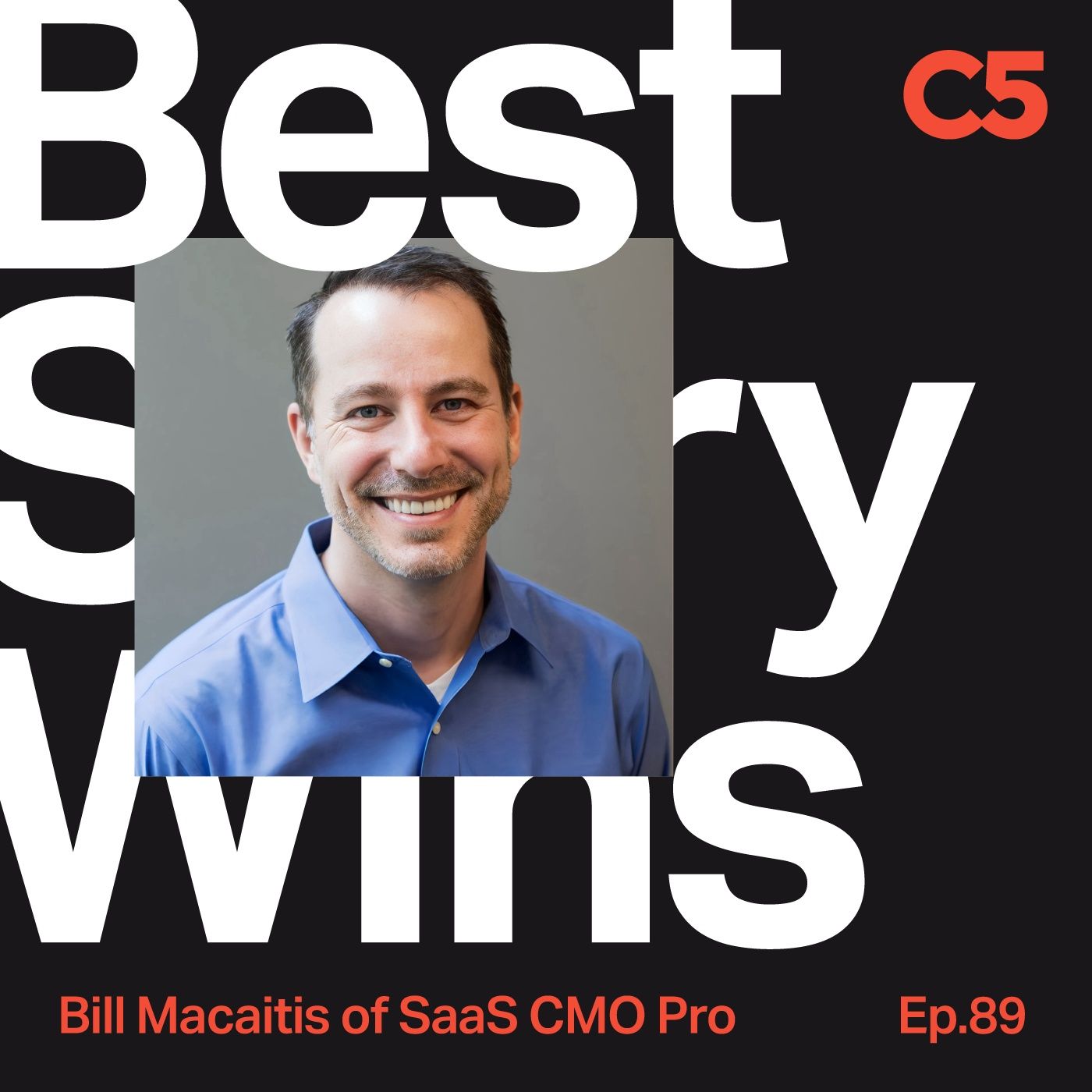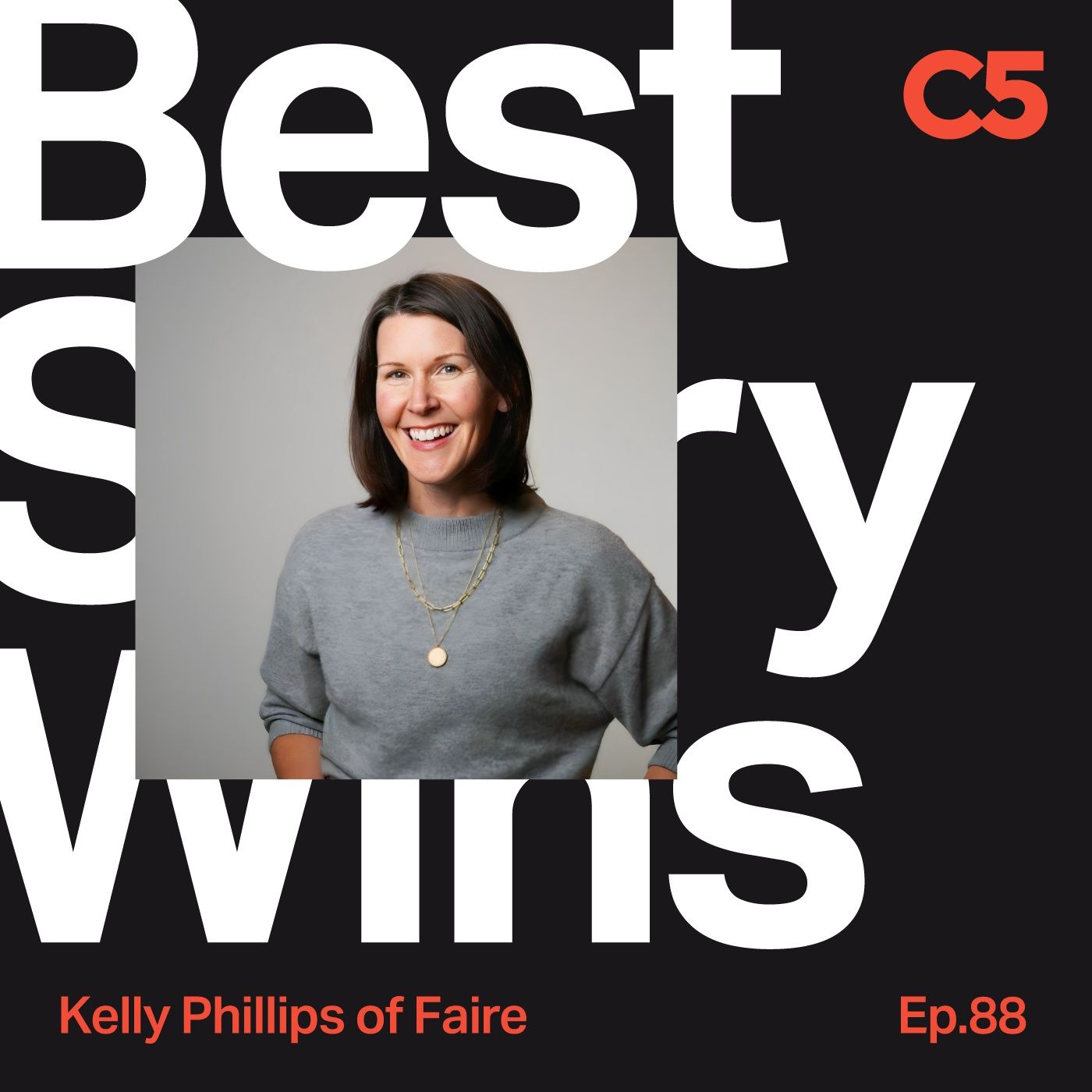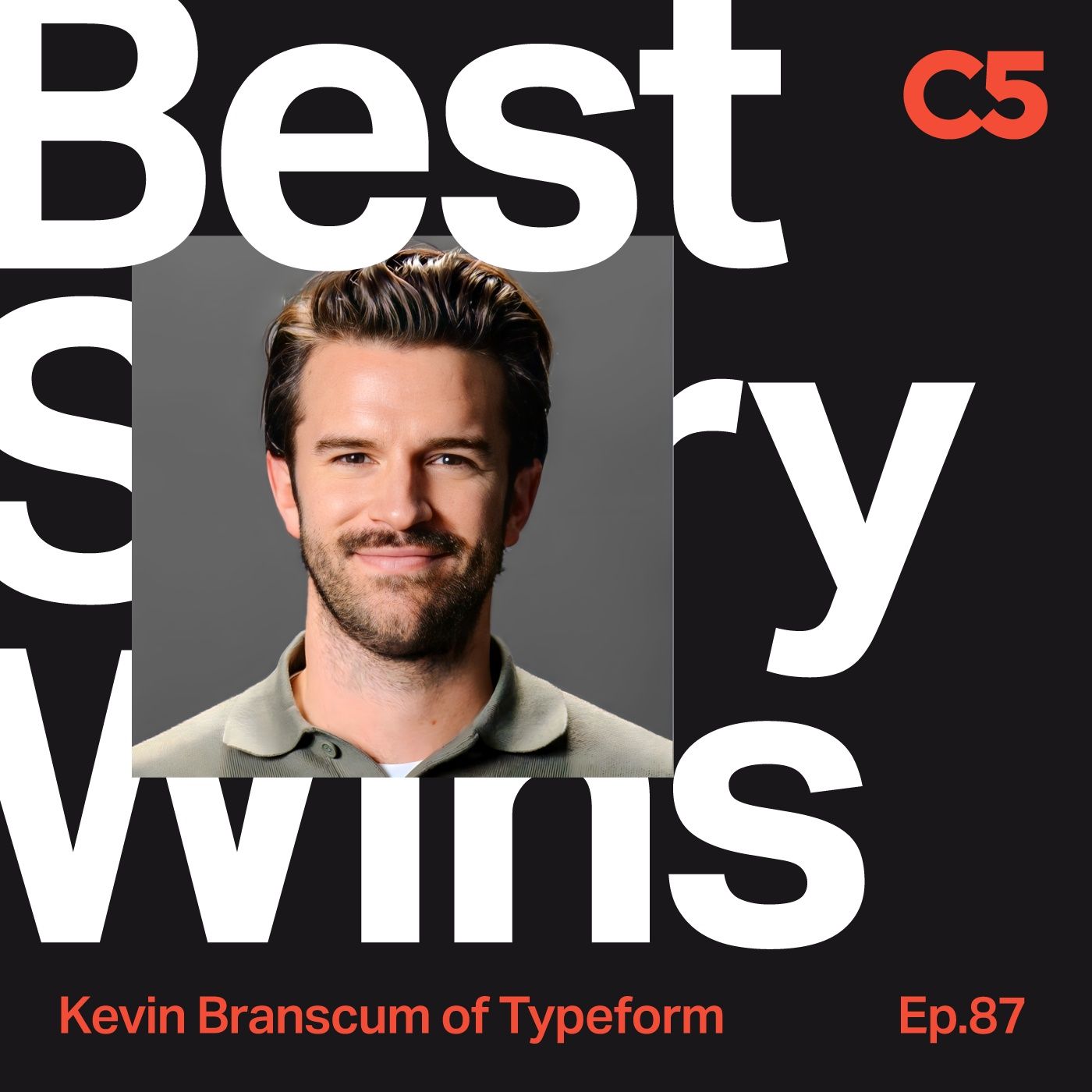Discover Best Story Wins
Best Story Wins

Best Story Wins
Author: Column Five
Subscribed: 6Played: 41Subscribe
Share
© Column Five
Description
Welcome to “Best Story Wins,” a podcast for marketing and branding professionals looking to unlock their growth potential. Hosted by Column Five—a B2B marketing agency that specializes in brand and content marketing for SaaS companies—each episode features insightful conversations with industry leaders who are winning customers’ hearts and minds by building world-class brands.
Tune in to hear expert insights, hard-won lessons, and key strategies to take your own marketing efforts to the next level.
Tune in to hear expert insights, hard-won lessons, and key strategies to take your own marketing efforts to the next level.
107 Episodes
Reverse
Your brand isn’t losing to competitors, it’s drowning in “helpful” content no one remembers. In an AI-everywhere world, bland is broken and volume is just a faster way to disappear.If LLMs can write what you ship in 10 seconds, why would a buyer choose you?This week, Sylvia LePoidevin delivers the reality check B2B marketers have been dodging: content volume is a commodity, brand is the moat. We dig into how AI-native teams actually work (tastemakers and operators), why “helpful” guides are table stakes, and how human stories, conviction, and point of view become the only defensible edge in a world where production is free. We also get into:Content brands > corporate blogs: Building something people follow, not just something you publish.Helpful is dead: Why every piece needs a person, a story, and a spine—or it’s AI fodder.Anchors and distribution: Human-made “anchor” content, AI-powered repurposing, zero soul lost.Manifestos, not messaging decks: Founder-fueled conviction as the real brand operating system.Brand as last moat: Community, ecosystem marketing, and taste as the next-gen B2B unfair advantage.
Your brand isn’t losing to competitors, it’s getting ghosted by the algorithm. As AI eats search, the “spray and pray” content playbook turns invisible. Are you training the models…or training your team to burn cash?This week, Jenna Hannon, Founder & CEO of Hatter, drops a State of the Union that B2B marketers need to hear: SEO isn’t dead, AEO (AI Engine Optimization) is here and lazy tactics are DOA. We unpack why LLMs reward actual marketing (crisp messaging, specific content, real PR) and punish AI-slop; how to merge SEO, AEO, and content into one motion instead of siloed teams; and why product marketing is the new growth core powering every channel.We also get into:SEO → AEO: Same inputs, new outputs and the extra layers that matter now.Quality > quantity: Why “programmatic, no-human” content craters (and how Google/LLMs sniff it out).Metrics that matter: Beyond traffic to AI visibility, context, and link-back citations that convert.Org design for 2026: Product marketing as the engine; experts in the loop; PR that teaches LLMs.
Your funnel isn’t broken, but your nerve is. “Best practices” are just average practices with better PR. If every headline, homepage, and hot take sounds the same… what’s the one bold move that makes you unforgettable?In this episode, Udi Ledergor, Chief Evangelist at Gong and author of Courageous Marketing, torches the safe playbook and helps us build a braver one: a sharp, differentiated POV that slices through “sea of sameness” B2B. We get brutally practical on how to stop shipping beige content, why the CEO (not marketing) owns the brand, and how psychological safety unlocks the kind of creative risks that actually move pipeline. We also cover:Why “best practices” guarantee mediocrity and how to replace them with courageous bets.How to punch above your weight at tentpole events without buying the $500K booth.The 3-part brand promise test (and how most orgs break it in customer support).How to interview your CEO and Sales for risk tolerance before you take the job.Using AI to kill drudgery, not taste so your POV stays unmistakably human.
Marketing is drowning in AI sludge, vanity dashboards, and “spray and pray” content. Your brand is getting lost, not because your product is weak, but because your taste is.In this episode, we sit down with Andrew Lee, Partner Marketing Leader at Microsoft, to torch the illusion that more content equals more impact. Together, we unpack why “brand vs. performance” is a fake fight, why taste is the last unfair advantage, and how to build owned distribution that survives algorithm mood swings. Your CMO will either thank you or feel attacked.We also cover:Annual planning as a power move: kill random acts of marketing.Turning founder POV into a scalable channel (without turning them into a dancing bear).How to benchmark “taste” (with simple, brutal quality bars your team can actually use).Converting narrative into numbers: story→search→sales enablement→SQLs.The “No Rented Moats” playbook: email + podcast + events > social roulette.
LLMs are already “deciding” your brand for buyers. Are you shaping that story or letting the machine write it? If your marketing still sounds like everybody else’s, congratulations: you’ve trained the models to ignore you.This week we rip into the hottest B2B reality: AI Engine Optimization (AEO) meets human-only brand. Ari Yablok, head of brand at Island, shows how to beat sameness by sending clear “this is new” signals, building experiential brands that people feel (not just read), and using unreasonable hospitality to make products and events feel theirs, not “yours.”We also cover:AEO is the new SEO: how to show up inside LLM answers and make people prefer you before they ever ask a bot.Signals over slogans: designing booths, visuals, and copy that telegraph “category shift” without a single bullet point.Unreasonable hospitality in B2B: turning product nuance and in-person moments into retention (and reputation) machines.The “feeling of knowing”: why brand confidence shortens deals—even when buyers can’t explain why.Human as the counter-trend: embracing curated flaws and analog touchpoints to stand out as AI perfects the average.
Budgets are shrinking, patience is thinner and the CMO seat is a revolving door. Keep playing the old playbook and you’re next.What if the path forward isn’t “more content, faster”, but a hard reset on power, process and what we even call “brand”?In this episode, Drew Neisser, Founder of CMO Huddles, drops a reality check on B2B: CMOs are operating in Antarctica—hostile, short-term, and PE-pressured and it’s still the most exciting moment in marketing. We get blunt about the “do more with less” lie, why “brand” is a budget-killing word (start saying “reputation”), and how AI should first nuke your workflows and org chart before you let it ghostwrite your strategy.). This is the insider’s guide to surviving the freeze and shipping work that closes.We also cover:CMO power plays: why owning Partnerships/Rev levers earns a real seat at the table.Short-termism judo: aligning with CFOs on “metrics that matter” and fixing attribution theater.What actually converts now: late-stage, face-to-face moments (small dinners > giant trade shows).Direct mail’s comeback: high-impact, targeted sends that unblock stalled deals.
Everyone’s racing to “do more with less,” then wondering why everything sounds the same. Budgets shrink, headcount drops, and the AI mandate lands like a memo from Mount Olympus: use it, ship faster, cut costs. Here’s the plot twist: AI isn’t your edge but your point of view is. If your story’s bland, the tech just scales blandness.In this episode, Julien Palliere, AI Strategist at Column Five joins Jason and Josh to deliver a necessary reality check.We unpack why “just add AI” is a lazy brief, how AEO is quietly disintermediating brands, and why volume is the enemy of results. The verdict: bad marketing makes you generic, not AI. We also cover:The Wedge System: Turning a sharp POV into a repeatable AI-powered content engine.Personalization That Actually Personalizes: Using CRM, 6sense, and LinkedIn signals to change copy by persona in real time.Where AI Belongs (and Doesn’t): Map the workflow, target structured/repeatable steps, avoid breaking fragile creative processes.
Marketers are hooked on attribution perfection. Meanwhile, your buyers are ghosting and your “AI-powered” campaigns sound like everyone else’s. What if the edge isn’t more dashboards but it’s better judgment?In this episode, Nicole Gates, VP Growth Marketing at Varonis tears up the playbook B2B keeps clinging to. She shows how a “process person” builds a launch machine that actually ships, why tiering by customer impact (not internal hype) changes everything, and how moving SDRs under marketing with real SLAs turns MQL theater into pipeline. We dig into the noisy AI arms race (robots fighting robots), shifting budget from paid-to-play to earned trust via thought leadership, and using AI where it improves outcomes (routing, enrichment, speed-to-lead), not where it creates slop.We also cover:How to tier your launches by what matters to customers, not your org chart.Why the best growth marketers think more like editors than analysts.What happens when you replace data obsession with decision confidence.
When everyone’s chasing quick wins, it’s easy to forget the one lever that compounds everything: brand clarity. But cramming “agentic AI” into your homepage won’t save you, it just makes you sound like the chorus.In this episode, we sit down with Jess Ellis, Head of Brand, Content, Creative & Comms at Attentive, to talk about what it really takes to build a brand that drives pipeline in a crowded B2B market. Jess gets candid about bringing a hypergrowth org back to its foundation-mission, values, and a point of view people can actually feel. We dig into consent-based personalization that respects customers, why brand and demand aren’t enemies, and how to use AI as a speed-up.We Also ExploreWhy slapping “AI” on your homepage isn’t a strategyHow to make personalization feel human, not creepyBrand vs. demand is a fake fight (and how to prove it)The metric that earns budget: brand health with teeth
If your marketing feels harder than it should, you’re not imagining it. So what’s the smarter way forward?In this episode, Adam Greco, Product Evangelist at Hightouch argues for a simpler model: composable CDP. Instead of locking yourself into a monolithic suite, you keep data where it already lives and activate it directly. That means days instead of quarters to get value, and less money wasted on campaigns that annoy customers instead of delighting them. Adam pulls from decades in analytics to show how organizations can finally stop tripping over their own tech, build trust between data and marketing, and focus on the few initiatives that really move the needle.The question: are you doing more, but achieving less?We also explore:Why annual planning done right can be a superpower, not a slog.How to kill the “brand vs. performance” tug-of-war with shared goals.The messy reality of category creation and how not to get steamrolled.Why short-form video is quietly replacing SEO as the new credibility engine.
Everyone’s talking about AI, but let’s be honest, most B2B brands still sound like copy-paste corporate speak. The scary part? While you’re stuck writing “safe” content, your competitors are out there building cult followings.On this episode, Jason and Josh talk with Sandy Mangat, Head of Marketing at Pocus, about what it really takes to make people care. Sandy has worked in product, growth, and brand teams, so she’s here to share the lessons you won’t find in a playbook. From building a community people actually want to be part of, to cutting through the AI hype without sounding like a bot, this conversation is all about marketing that feels alive.Here’s what we dig into:Why so many startups crash when product, growth, and brand don’t align.The real secret to category creation (spoiler: it’s not just slapping “2.0” on a slide).How to turn a community from “nice idea” into a genuine growth engine.The fine line between brand personality and just being unclear.Sandy’s one-line marketing philosophy: everything is easier when you’re famous.
Marketers are under constant pressure to prove impact. Often with smaller teams and tighter budgets. The challenge? Balancing brand building with demand generation while keeping content fresh and effective.In this episode, Jess Cook, Head of Marketing at Vector, shares how she’s tackling that balance in real time. Jess talks through practical ways to get more value from every piece you create, without burning out your team. She explains why “minimum viable content” can help you move faster, how repurposing can multiply your reach, and why even unexpected moments (like a CEO going rogue on LinkedIn) can become brand building opportunities.We also cover:How to establish authority in a new category.Why repurposing can be your most effective growth strategy.The benefits of testing fast instead of chasing perfection.How to turn unpredictable moments into authentic brand stories.The evolving relationship between brand and demand.
When AI can spin up a logo in seconds and templates are everywhere, it’s fair to wonder: why hire a designer at all? Because people don’t connect with “good enough.” They connect with taste, the kind that feels intentional, lived-in, and real.In this episode, Andrew Chen, Head of Brand Design at Hive, makes a simple case: tools help, but taste wins. He talks about how skating and the hardcore scene taught him to make things people actually want, why trust (not slide decks) gets bold ideas approved, and how the next wave favors curators who know what to keep and what to cut. Andrew’s path is a reminder that great work isn’t about pedigree; it’s about context, craft, and caring enough to sweat the details.We also get into:How building trust gets buy-in faster than any moodboard.Using “yes, and” to turn rigid briefs into better ideas.Why juniors shouldn’t wait for permission to pitch the risky thing.How food (seriously) can sharpen your storytelling instincts.
When everyone’s shouting that they’re “#1 in AI,” how do you actually stand out? Sometimes, the move isn’t a flashy campaign—it’s just saying what you mean, clearly and confidently.This week, we sit down with Scott Smith, VP of Brand at Intercom and the creative mind behind Fin, their new AI agent. Scott speaks about how they built a brand that breaks the rules—ditching rigid style guides for something more like a magazine: expressive, evolving, and full of soul. We talk about what it takes to launch a new brand inside a legacy company, how “boring” billboards became their secret weapon, and why AI isn’t here to steal creative jobs—it’s here to level up the whole game.We also get into:- Why great art direction matters more than ever in an AI-first world- How Intercom reimagined branding as a living, breathing system- Letting go of the “creative genius” myth and building with your team- What it looks like when in-house creative teams run like agencies
With everyone talking about AI, it’s easy to feel like your brand has to shout just to be heard. But sounding like everyone else isn’t the answer, it’s a missed opportunity to connect in a meaningful way.In this episode, we sit down with Steph Bowker, Head of Marketing at Metaview, to talk about what it really takes to stand out in today’s crowded B2B landscape. Steph shares her honest perspective on building brands that feel human, specific, and rooted in real value. We explore what makes people care, how to create a brand that feels lived-in and why thoughtful storytelling (inside and outside your company) might just be your strongest asset.If you’re looking for practical ways to cut through the noise without losing your voice, you’ll want to hear this one.We Also Explore:Why slapping “AI” on your homepage isn’t a strategyHow to turn customers into your most powerful marketing channelWhat makes a real community (hint: it’s not just a Slack group)How smaller teams can punch way above their weight with sharp storytelling
Maybe it’s not a content problem. Maybe it’s a clarity problem.With AI-generated posts flooding every channel and SEO playbooks changing by the week, B2B marketers are creating more content than ever—yet somehow, it’s hitting with less impact. So what actually sets a brand apart today? It might come down to something deceptively simple: better storytelling.In this episode, Roman, Head of Marketing at Sifflet, shares his thoughtful take on why “90% of marketing is content”—and why we need to rethink how we approach it.We also discuss:Why founder content is peaking—and what comes nextThe quiet return of PR, direct mail, and other "dead" tacticsThe one field in your contact form that tells you what your dashboard never will
Everyone’s chasing AI—but what if the real magic in B2B is a rap video, a meme, and two actors with a camera?While most brands stick to safe, polished playbooks, Chris Cunningham is building ClickUp’s marketing like it’s a full-blown media company—and it’s working. In this episode, he takes us behind the scenes of how their small but mighty team racked up 200 million+ impressions by leaning into creativity, comedy, and community.Chris, one of ClickUp’s original team members and now Head of Brand, shares the real (and often hilarious) story of how they went from startup scrappiness to building an in-house content engine that moves the needle. From hiring actors full-time, to turning their content meetings into writers’ rooms, to making rap albums that actually convert.We talk about:The content framework that helps their team test and scale what really worksWhy they bet on humor at the top of the funnel—and what makes it landHow they avoid burnout while making videos every weekThe limits of AI content (and why originality still matters most)What most B2B teams get wrong when they try to “act like media companies”
Let’s be real: most B2B brands are stuck on repeat. Same buzzwords, same bland websites, same tired playbooks. And in a sea of sameness, nobody stands out. So how do you make people actually care?In this episode, we sit down with Bill Macaitis, founder at SaaS CMO Pro. Bill pulls back the curtain on what’s broken in B2B marketing and how to fix it. Spoiler: it’s not another lead-gen campaign or cranking out more content. It’s about building a brand people actually remember.If you’re tired of playing it safe, this one’s for you.We Also Get Into:The secret behind customer marketing that actually drives growthHow to create bold, consistent brand moments without becoming a robotWhy most marketing teams lose trust—and how to win it back
We’re creating more content than ever—but at what cost to meaning and connection?In this episode, Kelly Phillips—VP of Brand Marketing at Faire, and former brand leader at Airbnb, YouTube, and Google—shares what it really takes to build a brand that people trust and feel connected to.We talk about what makes brand matter in the age of AI, how to build trust on both sides of a marketplace, and what it looks like when your brand actually helps people succeed—not just sells to them.We also discuss:Why Faire wants to be a partner, not just a platform, for small retailersThe “Fair Forecast” and the power of data-driven, non-boring trend reportsWhy early brand investment is no longer optional for AI-first companies
If your brand doesn’t spark a feeling, it’s already forgettable. In a world where every product looks the same, the only thing that truly sells is vibe.B2B marketing is broken. Everyone’s selling the same tools with the same bland copy—and in the AI era, product parity is only getting worse. So how do you stand out when sameness is the default? You build a brand people actually feel something about. In this episode, Kevin Branscum, VP of Brand Marketing at Typeform, breaks down how to inject personality, culture, and staying power into your B2B brand.We also discuss:Why most B2B brands sound like AI wrote them—and how to sound human againHow to borrow from the playbooks of fashion and luxury to build worlds, not just marketing campaignsHow to think beyond spreadsheets and bring real people—your customers and their customers—into the heart of your marketing


